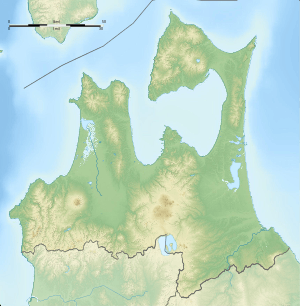Shōjujidate Castle
| Shōjojidate Castle 聖寿寺館 | |
|---|---|
| Nanbu, Aomori Prefecture, Japan | |
 Shōjojidate Castle 聖寿寺館  Shōjojidate Castle 聖寿寺館 | |
| Coordinates | 40°24′43″N 141°15′56″E / 40.41194°N 141.26556°E |
| Type | hirayama-style Japanese castle |
| Site information | |
| Open to the public | no |
| Condition | ruins |
| Site history | |
| Built | Kamakura period |
| Built by | Nanbu Nobunaga |
| In use | Muromachi to Sengoku periods |
| Demolished | 1539 |
Shōjojidate Castle (聖寿寺館 Shōjoji-date) was a Muromachi period Japanese castle located in what is now the town of Nanbu, in Sannohe District of Aomori Prefecture, in the Tōhoku region of far northern Japan. It was also known as the Moto-Sannohe Castle (本三戸城 Moto-Sannohe jō). It was located at a strategic junction of the Ōshū Kaidō with the Kakuno Kaidō and the Mabechi River.
Shōjojidate Castle was a hirayama-style castle built on a roughly trapezoidal 20 meter hilltop, partially protected to the north by a 20 meter wide dry moat, and by steep cliffs on other sides. It was one of five fortifications built by the Nanbu clan in the Kamakura period to secure their control of Nukanobu District of northern Mutsu Province, and was erected by the 11th hereditary chieftain of the clan, Nanbu Hideyoshi.
The fortification was more of a fortified house than a true castle, and located only 700 meters west of Hiragasaki Castle and four kilometers north of Sannohe Castle. It was located adjacent to the Nanbu clan temple of Shōjo-ji, from which it takes its name. It served as the residence of the Sannohe Nanbu clan for over 200 years, until the time of the 24th hereditary chieftain, Nanbu Harumasa, when it was burned down in a revolt by one of his retainers in June 1539.
The site of the castle, as well as the sites of the ruins of Shōjo-ji, the temple of Sankō-ji, and the Moto-Sannohe Hachiman-gu shinto shrine received protection as a National Historic Site on 30 September 2004. Portions of the site are occupied by local farm houses and fruit orchards.[1]
See also
References
- ↑ "聖寿寺館跡 しょうじゅじたてあと". Cultural Heritage Online (in Japanese). Agency for Cultural Affairs. Retrieved 6 March 2017.
External links
- Aomori Prefectural home page (in Japanese)
- Nanu town home page (in Japanese)
- Nanbu Tourist Information (in Japanese)